Desert Delights - Palm Springs - Page 2
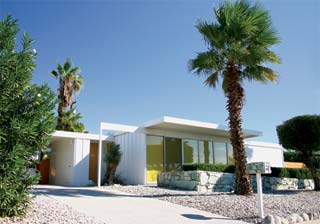 |
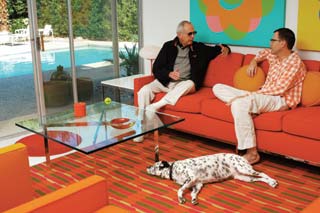 |
|
built in 1961 by the Alexander company. Owner Jim Isermann (above) visits with architect Donald Wexler. Photo: Barry Sturgill |
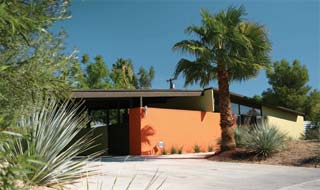 |
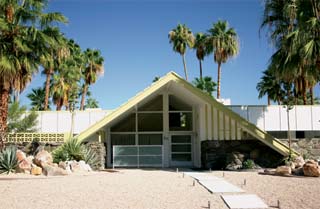 |
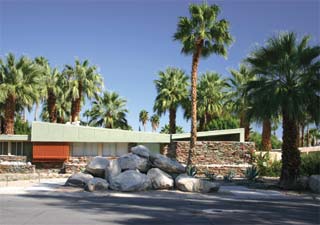 |
|
more than 2,000 Alexander tract homes in Palm Springs |
To Imber, Palm Springs modern architecture is beyond cool. It's beautiful and important and worth extended contemplation He urges clients to return on their own to the buildings the tour visits, then stand and watch as the sun moves across the sky and buildings change in the light. "The true architecture of the desert really evolves from the lighting and textures and colors and essence of the desert," Imber says.
That explains the brise soleil ('broken sun') screens of patterned concrete blocks, textured concrete block walls, notched corners found in many public buildings, walls of heavily scored concrete or heavily textured and deeply colored local rock. Broad awnings provide shade, and most houses have pools and avoid direct summer rays. But mid-century desert architecture was not designed for intense heat. Insulation was poor. Until recently many homes were vacation residences abandoned from late spring to mid-fall, and most still are.
Imber delights in the variety of styles that can be made to work in the desert. No place illustrates that better than a hillside spot on West Cielo Drive in the Little Tuscany Estates neighborhood. On one side of the road is Ellwood's classic Palevsky house, white and minimalist, dealing with the desert by challenging it. On the other is Stew Williams' Edris house, stone-walled and playful, which seems to grow from the desert.
Little Tuscany and the nearby neighborhood of Las Palmas contain many modern homes worth a look. Julius Shulman's twilight photo of Neutra's Kaufmann house from 1946, showing Mrs. Kaufmann by the pool, helped define modern architecture as sybaritic and serene. What you'll see today, hidden behind a stone wall and foliage, are just enough cantilevers to tempt.
One amusing house in Las Palmas was designed by the Alexanders' main architect, Bill Krisel, of the Los Angeles firm Palmer and Krisel, Inc. The house, with its polygonal bedroom floating beneath bat wings, was originally built as a spec house. But Bob Alexander's wife fell in love with the 'House of Tomorrow,' so she and her husband moved in. Today the house is better known for its connection with Elvis, who spent his honeymoon there. The 'Elvis Honeymoon Hideaway' is opened for concerts and other events.
Imber starts his tour in the center of town, at Tahquitz and Palm Canyon drives, where one of the earliest modern monuments can be spotted. All that will remain of Lloyd Wright's 1924 Oasis Hotel after a promised remodel will be its bell tower and remnants of the original shops. The hotel was built when the town was just developing as a vacation draw around the Cahuilla Indian's hot springs. Wright, the son of Frank Lloyd Wright, had a distinguished career all his own.
Few pre-World War II modern landmarks remain intact or easily viewed. One that does is the elegant Ship of the Desert, a Streamline Moderne home designed in the early 1930s by Los Angeles architects Adrian Wilson and Earl Webster. Another pre-war gem is Neutra's Grace Miller house, an unpretentious but elegant series of intersecting rectangles that can be seen on Indian Canyon Drive. Frey's Movie Colony Inn, also from the '30s, was built when Hollywood stars were making Palm Springs their own.




